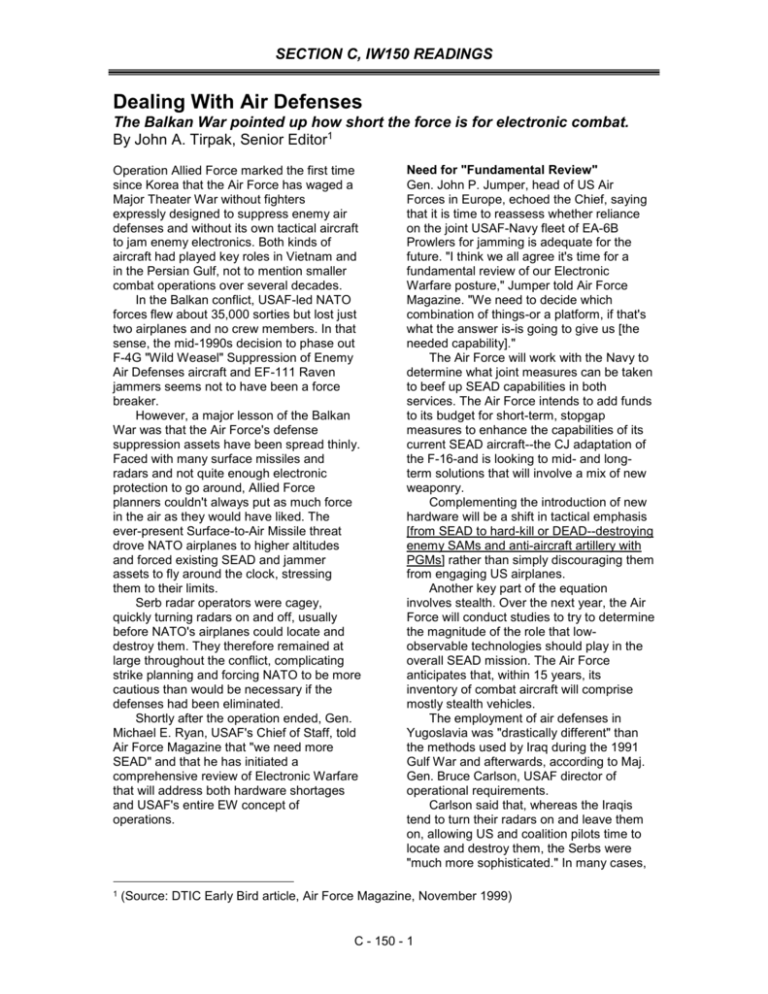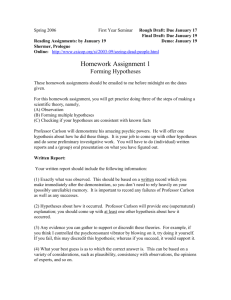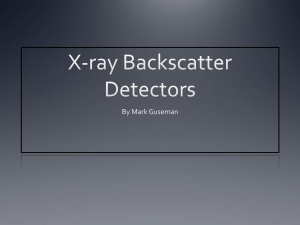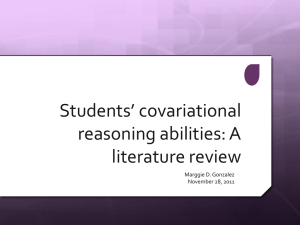5 - The Information Warfare Site
advertisement

SECTION C, IW150 READINGS Dealing With Air Defenses The Balkan War pointed up how short the force is for electronic combat. By John A. Tirpak, Senior Editor1 Operation Allied Force marked the first time since Korea that the Air Force has waged a Major Theater War without fighters expressly designed to suppress enemy air defenses and without its own tactical aircraft to jam enemy electronics. Both kinds of aircraft had played key roles in Vietnam and in the Persian Gulf, not to mention smaller combat operations over several decades. In the Balkan conflict, USAF-led NATO forces flew about 35,000 sorties but lost just two airplanes and no crew members. In that sense, the mid-1990s decision to phase out F-4G "Wild Weasel" Suppression of Enemy Air Defenses aircraft and EF-111 Raven jammers seems not to have been a force breaker. However, a major lesson of the Balkan War was that the Air Force's defense suppression assets have been spread thinly. Faced with many surface missiles and radars and not quite enough electronic protection to go around, Allied Force planners couldn't always put as much force in the air as they would have liked. The ever-present Surface-to-Air Missile threat drove NATO airplanes to higher altitudes and forced existing SEAD and jammer assets to fly around the clock, stressing them to their limits. Serb radar operators were cagey, quickly turning radars on and off, usually before NATO's airplanes could locate and destroy them. They therefore remained at large throughout the conflict, complicating strike planning and forcing NATO to be more cautious than would be necessary if the defenses had been eliminated. Shortly after the operation ended, Gen. Michael E. Ryan, USAF's Chief of Staff, told Air Force Magazine that "we need more SEAD" and that he has initiated a comprehensive review of Electronic Warfare that will address both hardware shortages and USAF's entire EW concept of operations. 1 Need for "Fundamental Review" Gen. John P. Jumper, head of US Air Forces in Europe, echoed the Chief, saying that it is time to reassess whether reliance on the joint USAF-Navy fleet of EA-6B Prowlers for jamming is adequate for the future. "I think we all agree it's time for a fundamental review of our Electronic Warfare posture," Jumper told Air Force Magazine. "We need to decide which combination of things-or a platform, if that's what the answer is-is going to give us [the needed capability]." The Air Force will work with the Navy to determine what joint measures can be taken to beef up SEAD capabilities in both services. The Air Force intends to add funds to its budget for short-term, stopgap measures to enhance the capabilities of its current SEAD aircraft--the CJ adaptation of the F-16-and is looking to mid- and longterm solutions that will involve a mix of new weaponry. Complementing the introduction of new hardware will be a shift in tactical emphasis [from SEAD to hard-kill or DEAD--destroying enemy SAMs and anti-aircraft artillery with PGMs] rather than simply discouraging them from engaging US airplanes. Another key part of the equation involves stealth. Over the next year, the Air Force will conduct studies to try to determine the magnitude of the role that lowobservable technologies should play in the overall SEAD mission. The Air Force anticipates that, within 15 years, its inventory of combat aircraft will comprise mostly stealth vehicles. The employment of air defenses in Yugoslavia was "drastically different" than the methods used by Iraq during the 1991 Gulf War and afterwards, according to Maj. Gen. Bruce Carlson, USAF director of operational requirements. Carlson said that, whereas the Iraqis tend to turn their radars on and leave them on, allowing US and coalition pilots time to locate and destroy them, the Serbs were "much more sophisticated." In many cases, (Source: DTIC Early Bird article, Air Force Magazine, November 1999) C - 150 - 1 SECTION C, IW150 READINGS they waited until the last possible moment to emit and reveal their locations, Carlson explained. Serb operators, after launching weapons or relaying targeting information to other defense batteries, would quickly shut down the radars again. While the reduced radiating time cut down on Serb successreduced tracking and targeting time produces less-effective missile guidance-it also cut down on NATO's effectiveness at finding and destroying Serb SAM batteries. "The SEAD capability that we've built in the US Air Force is a little bit dependent on the enemy fully utilizing his assets," Carlson said. The rapid on-and-off tactic "cuts down on the effectiveness of your SEAD campaign," he emphasized. "If they're not emitting, then you're not suppressing very much." Multiphase Destruction Lt. Col. Sal Collura is the deputy operations group commander of the 20th Fighter Wing, Shaw AFB, S.C., in which much of USAF's SEAD capability resides. He said that, early in an air campaign, USAF planners concentrated on destroying enemy air defenses at a strategic level. Commandand-control sites and the electronic sinews that create an integrated air defense system typically are eliminated with cruise missiles. "Then, we follow up with strikers--[such as F-15E and F-16 fighters equipped with laserguided bombs]--to take out known, fixed air defense sites," said Collura. Later, though, when the threat has been pushed down to mobile radars and missiles, the bulk of the SEAD effort lies with the F16CJ and the High-speed Anti-Radiation Missile, Collura said. The AGM-88 HARM is the principal US weapon against pop-up radar threats. It homes in on the source of designated radar emissions. HARMs are typically fired as quickly as a radar can be detected and its location roughly approximated. The missile is designed to keep flying toward the last known location of the radar even if the radar is turned off. The HARM's speed is such that, even if the radar is mobile, the missile will arrive before the radar can be moved. The drawback of the HARM is that it trades speed for warhead size. While a HARM can easily take out a radar vehicle, it is not powerful enough to also destroy the other attendant vehicles and missiles in a SAM system. The Serb cat-and-mouse approach did not bring down large numbers of Western airplanes. However, by staying off the air, many Serb air defense batteries survived, leaving an unknown number of air defense systems active and posing a threat through most of the conflict. This in turn required many dedicated SEAD missions long after the time when planners had expected to be able to shift SEAD airplanes to other tasks. As a result, the Air Force is changing its tactical view. "From a big-picture standpoint, we think it's important to go to a destructive capability," Carlson said. The Air Force wants to quickly fix the location of an entire emitting radar site and rapidly destroy it even if it is turned off. Carlson said development of these kinds of capabilities are funded in the current future years defense plan. The first step is an improvement of the current SEAD system, the F-16CJ and its HARM Targeting System, or HTS pod, which fits under the CJ's "chin." The HTS automatically performs many of the tasks that used to be the responsibility of the backseater in the F-4G. It scans the area, analyzing the frequencies, wavelengths, and pulsewidths of enemygenerated radar beams and microwave energy. Then, the HTS classifies these threats, identifies them, and presents the information to the F-16CJ pilot on his multifunction display. With the presentation of the data comes an itemization of the priority of the threats. No Guy in Back The F-16CJ has never been touted as an outright substitute for the F-4G. It lacks the F-4G's 360-degree capability, it can process fewer threats at once, it lacks the effective range of the F-4G's sensors, and it operates with less precision when it comes to identifying the location of an enemy emitter. However, the HTS can analyze threats automatically, and it can do so faster than the task could be done by the typical F-4G weapons systems officer. The F-4G backseater had to be trained to recognize wave patterns and the unique sounds of certain types of tracking and targeting radars and interpret them on the fly. C - 150 - 2 SECTION C, IW150 READINGS "The F-4G could gather all the data that was out there," Collura explained. Then, however, "it was up to the guy in back to interpret that data-that was the limiting factor. With the HTS, it has a filter on it so it only looks for what we tell it to look for." Collura said the F-16CJs, like their F-4G predecessors, can tease an enemy SAM radar into turning on by radiating in some frequencies or simply by just showing up. Another tactic is to blind enemy search radars, forcing the individual SAM sites to go autonomous and reveal themselves, he said. The Air Force is working to replace the current HTS with an updated version, called the R-7. Plans call for it to provide a better capability for geo-location of threat radars, Carlson said. In addition, 30 more F-16CJs were requested in the Fiscal 2000 budget to provide more SEAD capability for the Air Expeditionary Forces. The new jets would give each AEF greater SEAD capability to take along when they deploy. The move is designed to prevent the type from becoming a highdemand, low-density system. "We'll wear them out and wear the people out if we continue to use them as we have," Carlson noted. The 20th FW at Shaw fields four squadrons of the F-16CJ type. Two squadrons reside with the 35th Fighter Wing at Misawa AB, Japan; another with the 52nd Fighter Wing at Spangdahlem AB, Germany; and some aircraft are in the on-call "911" force at Mountain Home AFB, Idaho. Col. Daniel J. Darnell, 20th FW commander, said that he had sufficient F16CJs in Allied Force but was short of people and pods. "My limiting factor was personnel," he said. "If you're going to fly 24-hour [operations] ... that becomes very difficult." Darnell said his people could have kept up the pace some time longer, but "if they had needed additional people, no. I was just about maxed out." Moreover, Darnell said he was down to just one HTS pod available back at Shaw for training. Every one of the unit's other working pods was sent to Allied Force. The shortage affected the wing's ability to train, Darnell noted, but "it did not shut us down." In Allied Force, there were more F16 aircraft capable of carrying the pod than there were pods to go around, he observed. (There is $26 million in the budget to buy more HTS pods, Carlson noted.) Beyond more CJs and an update to the HTS, the Air Force wants to buy a targeting pod to complement it, Carlson said. USAF will compete three existing targeting pod systems and select one to help a CJ pilot better zero in on a threat radar. After an HTS finds the general location of a radar, the targeting pod's wide field of view could help further refine its location. Using its narrow field of view, the pod could then enable the pilot to use a laser-guided bomb, Maverick missile, or just about anything against the SAM system, Carlson said. The larger weapons would better ensure a hard kill of the SAM, he added. Chief of Staff Ryan "has pushed us very hard to lay out a program to do that," Carlson noted. Enhanced Jamming Powers In addition to acquiring these new "killer" airplanes, the Air Force and Navy will embark on a joint effort to enhance their jamming capabilities. The Air Force and Navy share the EA-6B Prowler tactical jammer, in that the two services each contribute funding for the system and use it for combat support. Some Air Force pilots and weapons systems officers fly the EA-6B, which can also shoot the HARM. Pentagon officials said they expect the Navy and Air Force will decide to accelerate the upgrade of older Prowlers and to deploy more of the available 123 airplanes as soon as possible. The number of EA-6B squadrons would rise from 19 to 20, with the 20th a dedicated expeditionary unit. Carlson said he doesn't anticipate that the Air Force will get its own dedicated jamming platform in the foreseeable future. "In a 40-wing Air Force, you could afford to have ... F-4Gs and EF-111s," he said. "In a 20-wing Air Force, I'm not sure we can afford to have that much specialization." The only areas in which the Air Force can realistically expect to maintain such specialty combat airplanes is in the air superiority and deep strike/interdiction roles, he explained. "We do need to have specialization in the high-tempo, very demanding, air superiority and deep interdiction airplanes. We just have to have that," Carlson said, C - 150 - 3 SECTION C, IW150 READINGS adding that the F-22 will inherit the air superiority role and the F-117 and F-15E will do the interdiction job well into the next decade. Defense suppression, though, will be a task that falls to the multirole F-16 and, later, the Joint Strike Fighter, he said. However, "if the demands of destructive SEAD are such that we can't do it with a multirole airplane like the F-16 or the JSF, then at some point in the future, we may have to reconsider, and maybe a new, dedicated JSF or F-15E or F-22 [would be applied to the SEAD or jamming mission]," Carlson said. "But that's certainly not on the drawing boards right now." He said he is aware that the Navy is looking at a Boeing proposal to develop a jamming variant of the new F/A-18E/F Super Hornet, which would replace the EA-6Bs when they reach retirement age in about 15 years. The Air Force is not contributing funds to such an effort, said Carlson. Analyze Alternatives Carlson reported that the US is now conducting an analysis of alternatives for a follow-on to the EA-6B, noting that "we're certainly playing very heavily" in it. The Navy has the lead, but the Air Force is beginning to come up with ideas for addressing the role. These ideas go beyond simply buying a new platform. "One thing that might be useful is a B-52 as a standoff jammer," Carlson noted. "Another thing that might be considered is the F-15E. [It's a] big airplane, [with a] big bomb load; it certainly could carry some pods." The services will also look at unmanned aerial vehicles for the SEAD role--perhaps in a destructive role or as a jammer, Carlson said. The Air Force has an uninhabited combat air vehicle program in the works which might serve as a solution. "It's certainly a candidate," said Carlson. Another element could be the Miniature Air-Launched Decoy, or MALD, a small, disposable air vehicle that appears as a fighter on enemy radar. Such a decoy could be used to draw away many enemy SAMs, Carlson said, but it must be affordable. Another possibility is a small loitering vehicle that could orbit the battlefield, waiting for enemy radar to be turned on; it could then attack the radar. Such a concept was once developed in the form of the Tacit Rainbow missile, but it proved too expensive and technically problematic. Technology has improved to the point where the idea may warrant another look, Carlson said. Once again, the question is whether the price can be made right. "Those weapons are only really useful if you're going to ... pre-emptively launch ... tens or hundreds of them. They have to be relatively inexpensive." Carlson contended, "As we approach this analysis of alternatives with the Navy, we will focus our attention on the lower bands, the acquisition-type radars." This, he added, will in turn allow the EA-6Bs to "focus their power and the things they do best up in the high band where the target trackers are-the SA-10 and the real formidable threats." Carlson said the third step in addressing Air Force SEAD requirements will be to develop the means to detect nonradiating systems and destroy them at night and in all weather. Such a capability is "not on the horizon, yet, [but] once you get that figured out, you can do all kinds of other things," he said. "You can figure out how to kill weapons of mass destruction." Playing some role in this next phase of SEAD will be the joint standoff weapon-a stealthy glide bomb-and the joint air-tosurface standoff missile-a stealthy, longrange munition. Anti-radiation roles have been suggested for both platforms, but even without special sensors for the task, they could be very useful in SEAD if an enemy SAM site were located by satellites or other sensors. Both would allow an airplane to attack the missiles from standoff distance, outside the threat zone. The solution will probably be a system of systems, Carlson predicted. "You probably can't put all that capability on an F15 or on a B-2 or JSF." The answer lies in "integrating intelligence, surveillance, and reconnaissance assets with shooters and tightening the timelines between when a system is detected and when ordnance can be dropped on it," he added. Tough to Beat Carlson said the SAM threat is getting tough to beat, in any case. "Double-digit SAMs are available on the open market," he said, referring to Sovietdesigned systems of the series SA-10 or C - 150 - 4 SECTION C, IW150 READINGS higher. "Seventy million dollars will buy you a battalion of those things, which is a couple of launchers and 16 to 20 missiles and a couple of radars-a pretty good capability, with a radius of a hundred miles or so." Two such systems on the Korean peninsula would be "a formidable threat to take out," said Carlson. He added, "Put two of those in Yugoslavia, and essentially ... most of the country is off-limits to a [nonstealthy] airplane unless you bring in a fairly heavy support package." Carlson said the Air Force "didn't learn anything tremendously new about stealth" from Operation Allied Force, due to the constraints of airspace and the political restrictions on the use of force. However, he said, one of the results of the operation may be a new impetus to integrate stealth assets with the rest of the force in a more open way and better than has been the case thus far. "We're doing that," he noted. "[Ryan] has put a lot of emphasis on that. I think you'll see a much more open Red Flag scenario, ... with stealth assets being incorporated." It may be time to declassify some aspects of stealth operations so US commanders can better work with stealth airplanes and include them in their thinking, thus operating more efficiently with them, Carlson said. "There may be more advantage gained than lost ... by declassifying some things ... and having everybody on your side know [how best to employ stealth airplanes]." For example, he said, the Air Force might want to reveal additional tactical data on the F-117 stealth fighter so that US commanders know "the optimum way to employ an F-16 package with an F-117 flight. ... Do you have them fly close or far apart? Where do you want the jammers? What frequencies do you want the jammers to work on, vs. where you want your HARMs? Do you want them to come in first, the middle, or at the end? And those are things we know how to do, but not everybody in the Air Force knows how to do it, because ... we have kept those employment concepts very closely held. Maybe it's time to be more open." Lt. Col. Steve Searcy, commander of the 78th Fighter Squadron at Shaw deployed to Allied Force, said the SEAD training he and his pilots received in Red Flag and Green Flag exercises turned out to be highly realistic. The Serb anti-air capability was about what he expected, stated Searcy, except for some surprises that indicated that the Serbs were welltrained and sophisticated in their tactics. "We were up against ... sophisticated operators who [were] going to pick and choose when to engage and who were tactically smart about doing so." He noted that the Serb operators believed they'd shot down more NATO airplanes than they actually did, which was not much of a surprise. To them, he said, "the missile tracked and went up and exploded as advertised. They had no way of knowing if it blew up chaff." Still, said Searcy, the real world matched "very closely to the systems we train for and studied." He said he's not of the school that thinks that the Flag exercises are unrealistically tough. "You train so that you know you can handle anything that comes at you," he said. "It's designed to be the worstcase situation." The fact that no aircrews were lost ... "is a tribute to those training programs," he added. C - 150 - 5





